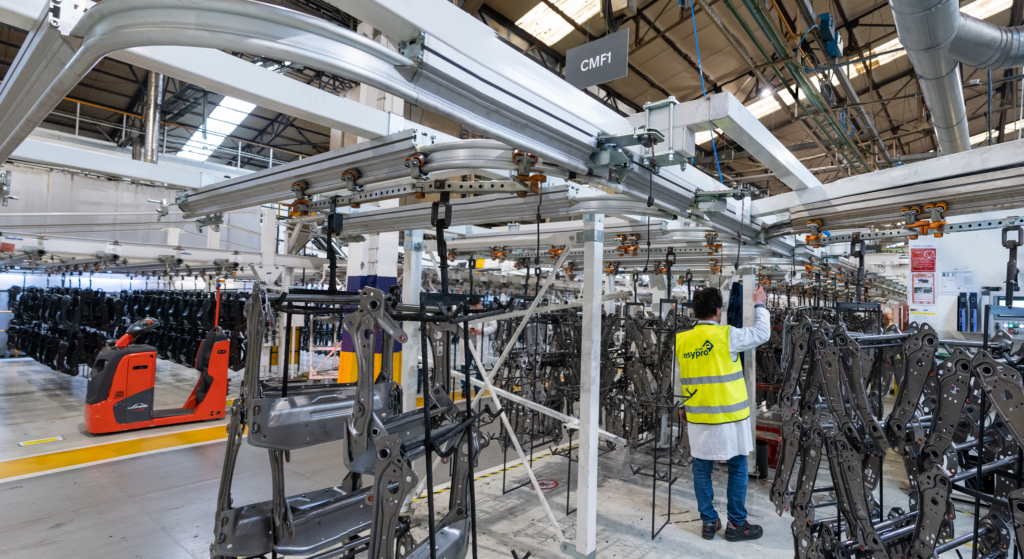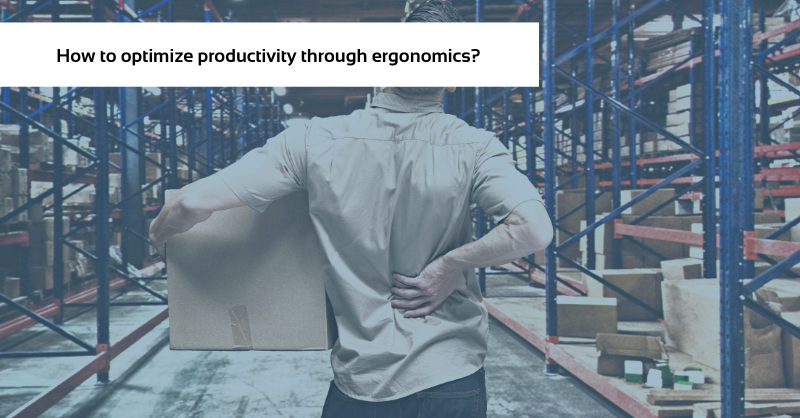Ergonomics is an essential discipline in any work environment. Since the Industrial Revolution, the well-being of workers has been a concern for many entrepreneurs. Particularly in jobs where the handling of pieces is a daily task, ergonomics becomes a key factor in ensuring the safety and health of the human team. Did you know that the term “ergonomics” comes from the Greek “ergon” (work) and “nomos” (law)? The term was first used in 1857 by the Polish Wojciech Jastrzębowski, although it is a discipline that has been developing since the Industrial Revolution in the 18th century. Since then, ergonomics has evolved to include psychological and social factors, and has become an essential part of every company. Keep reading and discover more facts and tips about ergonomics!
Identifying the silent enemies: How ergonomic risks can affect people’s health
In the field of medicine, ergonomics refers to the study of how the interaction between persons and their work environment can affect their physical and mental health. For factory and warehouse workers, ergonomic risks are a common problem that can cause a variety of medical disorders, such as back pain, musculoskeletal injuries, fatigue, stress, and other health issues.
Factory and warehouse operators often work with heavy loads, perform repetitive movements, and maintain uncomfortable postures for long periods of time. All of this can exert significant pressure on their bodies, especially on the spine, joints, and muscles. In addition, the lack of proper support and inadequate design of the work environment can increase the risk of workplace accidents.
Handling parts can be particularly exhausting. Repetitive and monotonous activities can cause repetitive strain injuries (RSI), including tendinitis, carpal tunnel syndrome, and bursitis. Additionally, the stooped posture that workers may adopt can cause neck and back pain, as well as muscle fatigue. It is important to note that these risks may not be immediately apparent, as they often accumulate gradually over time, eventually leading to serious long-term consequences such as chronic injuries.
It is important to pay attention to these silent enemies and take preventive measures to minimize ergonomic risks in the workplace. The health and well-being of the human team should always be a priority in any company.
Designing an ergonomic work environment: what measures should we take to ensure the well-being of workers?
Designing an ergonomic work environment involves considering a series of key factors that can affect the health and safety of workers. Below are some preventive measures that can help minimize ergonomic risks in the workplace.
- Risk assessment: It is important to conduct a risk assessment in the workplace to identify problem areas and determine what measures should be taken to minimize ergonomic risks. Risk assessment may include observing workers in their work environment, reviewing medical reports, and consulting with the team and their representatives.
- Ergonomic design of the work environment: It is important to ensure that the work environment is designed ergonomically. This may include the use of ergonomic tools and equipment, and proper organization of machinery and materials.
- Training and education: It is essential that workers receive adequate training and education on best ergonomics practices, as well as on the proper use of available ergonomic tools and equipment in the workplace.
- Breaks and task rotation: It is important to allow staff to take regular breaks to avoid muscle fatigue and reduce the risk of repetitive strain injuries. In addition, task rotation can help reduce repetitive exposure to the same activities and movements.
- Promotion of physical activity: Physical activity should be promoted among the workforce, which can help improve health and reduce the risk of injuries. This may include stretching activities, strength training exercises, and other physical activity programs.
By taking appropriate preventive measures, we can ensure the safety and health of people in the workplace, minimizing ergonomic risks and promoting a healthy and safe work environment.
What benefits does ergonomics have for the company?
In addition to the benefits for the health and safety of workers, ergonomics can also provide significant benefits for the company. By implementing an ergonomic work environment, businesses can reduce costs associated with work-related injuries and sick leave, increase work efficiency, and ultimately improve the quality of their products or services.
For instance, a Harvard University study found that companies that invest in the health and safety of their workforce get a higher ROI. Moreover, an ergonomic work environment can improve employee morale and job satisfaction, leading to increased employee retention and reduced costs associated with employee turnover. It’s important to note that ergonomics not only relates to physical health but also mental health.
The implementation of ergonomic measures can also enhance productivity and work efficiency. By designing workstations and equipment ergonomically, worker fatigue and tiredness can be reduced, enabling them to maintain higher concentration and energy levels throughout the day. Additionally, by reducing unnecessary and repetitive movements, production time can be improved and work errors can be reduced.
Interestingly, ergonomics can also have a positive impact on creativity and innovation in the workplace. A study from the University of Illinois found that a comfortable and ergonomic work environment can stimulate creativity in employees, leading to greater innovation in the company’s products or services. Additionally, the implementation of ergonomic measures can foster collaboration and teamwork, which can improve problem-solving and decision-making.
So, ergonomics is not simply a series of regulations, imposed by law or by company policies. Ergonomics should go far beyond avoiding risks. It should seek comfort and favor the interest of workers in their tasks and their work environment.
5 ways to improve ergonomics in the industrial sector
Creating a safe and comfortable work environment is crucial for any company to promote the health and well-being of their employees. To minimize the risks associated with working in a warehouse or factory, it’s essential for companies to take preventive measures. In this regard, we present five effective ways to improve ergonomics in these settings. These measures can be implemented by companies of all sizes and can help create a safe and healthy work environment.
- Adapting the layout to the workstations, not the workstations to the layout: A proper layout design is essential for safety and efficiency in a production plant or warehouse. A good plant design should adapt to the needs of workers, not the other way around. This means placing equipment and machinery in a way that allows easy accessibility and movement for workers, avoiding the need for unnecessary movements and the possibility of repetitive physical strain injuries. It is not an easy task, as we often face problems with the available space or obstacles that put the layout of the plant in the center, but the benefits of focusing on people justify this approach.
- Using picking assistance devices: Selecting and picking products in a warehouse involves a lot of repetitive movements that can result in injuries. The use of picking assistance devices, such as manual or automatic carts, reduces the need for manual lifting and transportation of heavy objects. This reduces the likelihood of muscle and skeletal injuries while increasing efficiency. Pick-to-light systems are also an efficient example of picking assistance devices, as they use LED lights to guide workers in product selection and collection, reducing visual fatigue, the possibility of errors, and improving work efficiency.
- Caring for environmental ergonomics: Environmental ergonomics involves considering how lighting, temperature, humidity, and noise can affect people’s health and performance. For example, curtains can be placed to reduce glare and shadows that allow for problem-free vision, using air conditioning systems to maintain a comfortable temperature, and maintaining a low noise level to reduce auditory fatigue.
- Automating repetitive tasks: Automating repetitive tasks can be an excellent way to improve ergonomics in the industrial sector. By reducing the need for workers to perform repetitive and forced movements, musculoskeletal injuries can be prevented, and work efficiency can be increased. Additionally, automation can allow the human team to focus on more complex and high-value-added tasks, which can improve the quality of the final product or service. Some automation solutions include mobile robots, transportation systems, and automatic material handling, among others. It is important to remember that automation should not be seen as a complete replacement for human labor, but as a complementary tool to improve ergonomics and productivity.
- Using industrial handling systems: The use of industrial handling systems is one of the most effective ways to improve ergonomics in the industrial sector. Industrial handling systems, such as Esyconveyor, Almaflex, and Esyair, which allow products to be hung on load units at a comfortable height, reduce the need for manual lifting and handling of loads by workers. These systems can also reduce product processing time and improve workflow efficiency. It is important to note that industrial handling systems must be specifically designed and adapted for the company and the type of product being handled, with the aim of maximizing their ergonomic and productive effectiveness. Thus, for example, at Esypro we carry out hook load studies to prevent the operator from having to push and pull a load greater than that recommended in the event of manual handling.

In essence, ergonomics in the industrial sector extends beyond just safeguarding the well-being and safety of workers; it can also yield considerable benefits in terms of efficiency, profitability, and overall job satisfaction. At Esypro, we’re deeply committed to crafting and implementing personalized and ergonomic industrial handling systems that facilitate the optimization of production processes and elevate the quality of the final product. We carry out risk analysis in the design of our solutions and we adapt to any existing regulations of our clients. With our unwavering focus on cutting-edge technology and innovative solutions, we’re dedicated to helping companies unlock their full potential while also prioritizing the health and welfare of their personnel. Get in touch with us today to learn more about how we can assist you in improving ergonomics at your organization!
